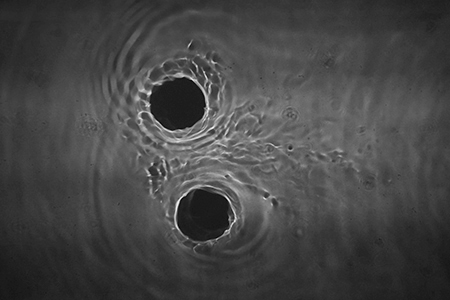 |
|
ER=EPR | 2017 | installation
in collaboration with William Basinski, Jean-Marc Chomaz
and LIGO.
Two counter-rotating vortices, joined together by a slender whirling bridge, drift through a long aquarium. Illuminating the vortex pairs from below the body of water, an expanded laser beam creates a ceiling projection of halo-encircled black holes connected by a wormhole. The vortices may collide with one another (as in the LIGO detections), and if the wormhole link rips apart, the black holes immediately dissipate.
Connecting two black holes through their interiors, might a wormhole form due to quantum entanglement? This mind-bending conjecture of Juan Maldacena and Leonard Susskind can be traced back to two papers from 1935, which were previously presumed to be unrelated to one another: “The Particle Problem in the General Theory of Relativity” and “Can quantum-mechanical description of physical reality be considered complete?” The former is referred to as the “ER” paper, which posited the existence of Einstein-Rosen bridges, currently known as wormholes. The latter paper introduced the “EPR” paradox or “spooky action at a distance", which was later termed quantum entanglement. Instantaneously linking separated particles regardless of their proximity to one another, entanglement has been thoroughly tested at ever greater distances over the past 30 years, and firmly established as a central aspect of quantum behaviour. Contrarily, wormholes still remain in the realm of pure thought experiments.
With the generous support of LIGO, Isabel De Sena, Fulcrum Arts and the Carasso Foundation.

© 1998 - 2023 Domnitch Gelfand
|
 |

